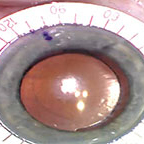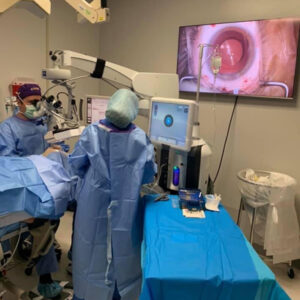ASCRS News: EyeWorld Journal Club
September 2023
by Naomi E. Gutkind, MD,1 Flavius A. Beca, MD,1* Ramsey Yusuf, MD,1* and Rebecca Lees, BS2* 1Bascom Palmer Eye Institute, University of Miami Miller School of Medicine, Miami, Florida 2McKnight Vision Research Center, University of Miami Miller School of Medicine, Miami, Florida
*These authors contributed equally to the review.

Associate Ophthalmology Residency Program Director of Research
Bascom Palmer Eye Institute
University of Miami Miami, Florida
While climate change poses a great threat to human health, the global healthcare sector itself is responsible for a large share (5–10%) of all greenhouse emissions.1–4 Globally, cataract surgery is one of the most common surgeries performed (more than 30 million procedures annually) and is therefore a significant contributor to the overall carbon footprint.5 Defining the carbon footprint is difficult, and methodologies vary widely. Past studies have divided emissions into three sectors: direct emissions from building energy use, direct emissions from the travel of patients and staff, and indirect procurement emissions.6 Winklmair et al. focused on the medical equipment component of the procurement sector, which prior studies have shown to be the single largest component to the overall footprint. Indeed, the global carbon footprint of cataract surgery varies a great degree from 6 kg CO2 equivalents in India to 130 kg CO2 equivalents in the U.K.6–8 The lower footprint in places like India have been attributed to reusable materials and reduced waste production, not only for cataract surgery but also in other contexts like obstetrics and gynecology. This study provides an actionable recommendation within the existing supply chain and practice patterns of single-use materials.
Methods
This multicenter retrospective study analyzed the makeup of cataract packages from three Austrian hospitals. Gray literature was reviewed to identify package components, using the material with the most detrimental environmental impact if a description could not be found. Components of each package were placed into a category of surgical gowns, cannulas, syringes, postoperative eye protection, surgical trays/bowls, knives, fluid management, drapes/covers, or packaging and entered into the GaBi Product Sustainability and Performance Software to calculate the global warming potential (GWP) of each component. A mean weight was calculated for each product type, then multiplied by sales figures from the three primary cataract package suppliers in Austria, which comprise 94% of the package sales in Austria. Because this study solely looked at cataract packages, factors such as electricity use, patient transportation, postoperative care, surgical gloves, phaco cassettes, individually packaged single-use surgical instruments, and viscoelastic device were not considered. The study also sent a survey on surgery waste disposal to every Austrian hospital and practice that performed cataract surgery; 25 sites participated and accounted for 77% of cataract surgeries in Austria.

Results
A total of 55 different cataract package compositions were evaluated. The average weight of materials within cataract packages across three hospitals was 0.74 kg (range 0.5 kg to 1.2 kg), corresponding to 2.3 kg CO2 eq per package. On average, the product category “drapes and covers” accounted for 52% of weight per cataract package (0.4 kg), followed by “surgical gowns” (0.2 kg) at 30%, “packaging” (0.1 kg), and the “other” category (0.04 kg), which included cannulas, syringes, and postoperative eye covers. Total package weight varied by up to 57%, and weights of drapes and gowns varied by 80% when comparing between the smallest and largest packages. Approximately 40% (0.3 kg) of cataract package materials were composed of fleece, and 50% (0.37 kg) were composed of plastics. Significant variation in both the quantity (counts between 2 and 9) and overall size of “drapes and covers” were appreciated. Measured sizing of various drape covers and gowns varied by 66% to 99% between different packages. When comparing the effects of waste disposal on the GWP, the authors found that CO2 emission could be reduced by 13,576 eq or 6.5% assuming a 100% recycling rate over a 100% waste incineration rate (195,804 kg CO2 eq with recycling compared to 209,380 kg CO2 eq with incineration). In the survey on material management, approximately 20% of eye departments reported a lack of appropriate recycling containers in cataract operating rooms, and 52% reported separating operating waste. Of the departments that have proper recycling of surgical waste, 76% also reported separating paper from plastic waste.
This study highlights the need for similar analysis in the U.S. and other large global economies to determine the impact of cataract surgical packages on the global carbon emissions.
Discussion
Winklmair et al. provided an analysis of cataract surgical packages in three Austrian hospitals to highlight the wide variability of packages and elucidate potential best practices to address greenhouse emissions from cataract surgery. The authors proposed an “Austrian standard cataract package” based on the lightest third of packages by weight and found that ubiquitous adoption of these standards may reduce CO2 emissions significantly by 34% in Austria. In a country with approximately 94,000 cases per year, this amounts to 134,586 kg CO2 equivalents according to their analysis. If this were applied to the U.S., where cataract surgeries amount to approximately 3.7 million cases per year (40x higher),9 the impact would be powerful. However, standardization of surgical packages may be more achievable in Austria where health policy is dictated by the European Medical Devices Directive. This recommendation may be difficult to achieve in a larger economy like that of the U.S. where healthcare regulations fall under the purview of both federal and state regulations. While there are three suppliers that represent more than 94% of package sales in Austria, the diversity and number of manufacturers in the U.S. and worldwide is likely much greater. Thus, differences in the legislative landscape and economic scale may limit the generalizability of the present study. This study highlights the need for similar analysis in the U.S. and other large global economies to determine the impact of cataract surgical packages on the global carbon emissions.
There are additional questions raised by this study. Although the authors discussed reusable surgical equipment as a means for reducing carbon consumption, this metric was not directly studied. The methodology assumes the selection of material with the worst life-cycle analysis from an eco-balance perspective if exact data was unavailable, but it is not mentioned how frequently this assumption was required. This may reduce the calculated effect of greenhouse gas reduction by standardizing packages. Lastly, the analysis of the surgical packs excluded other factors that contribute to the carbon footprint of cataract surgery, including disposable tubing, viscoelastic use, electricity consumption, transportation burden, and pharmaceutical products. A future analysis of all factors that contribute to the carbon footprint of cataract surgery may illuminate further avenues for intervention, including managing pharmaceutical waste, analysis of other disposable tools, and mitigating travel and appointment burden.
A future analysis of all factors that contribute to the carbon footprint of cataract surgery may illuminate further avenues for intervention, including managing pharmaceutical waste, analysis of other disposable tools, and mitigating travel and appointment burden.
Conclusion
The authors concluded that the large variability in the size and weights of surgical packages offers a strategy for reducing the carbon footprint of cataract surgery. A significant reduction in CO2 emissions can be achieved with universal adoption of a standardized surgical package in line with the lowest third of the materials analyzed. Their analysis supports this conclusion for Austria; however, the feasibility of this recommendation worldwide or in the U.S. may be challenging due to the economic and legislative landscape.
Potential environmental effect of reducing the variation of disposable materials used for cataract surgery
Winklmair N, et al. J Cataract Refract Surg. 2023;49:628–634.
- Purpose: To analyze the cataract package variability in 1 country, Austria.
- Setting: Austrian Departments of Ophthalmology.
- Design: Cross-sectional study.
- Methods: The cataract package components of 3 different Austrian hospitals were weighed and life cycle assessment on each product performed. This data was then extrapolated to the sales figures of the main Austrian cataract package suppliers to estimate the carbon footprint of all cataract packages used in Austria in 2021.
- Results: There were 55 different cataract package compositions in use with an average weight of 0.7 kg. These compositions differ significantly in weight and composition considering that the smallest package was 57% lighter than the largest package. The size of the surgical drapes also showed considerable variation, with a difference of up to 71%. This is substantial, considering that drapes and covers account for about 53% of the package weight.
- Conclusion: There was a considerable variation in package composition and product size, which could provide opportunities to save carbon dioxide emissions in cataract surgery. If all Austrian eye departments were to reduce the material quantities and drape sizes to the lower third of the cataract packages used in Austria in 2021, cataract package associated CO2 emissions could be reduced by 34%.
References
- Eckelman MJ, Sherman JD. Estimated global disease burden from US health care sector greenhouse gas emissions. Am J Public Health. 2018;108:S120–S122.
- Eckelman MJ, et al. Life cycle environmental emissions and health damages from the Canadian healthcare system: an economic-environmental-epidemiological analysis. PLoS Med. 2018;15:e1002623.
- Malik A, et al. The carbon footprint of Australian health care. Lancet Planet Health. 2018;2:e27–e35.
- Nansai K, et al. Carbon footprint of Japanese health care services from 2011 to 2015. Resour Conserv Recycl. 2020;152:104525.
- Bourne RRA, et al. Causes of vision loss worldwide, 1990–2010: a systematic analysis. Lancet Glob Health. 2013;1:e339–e349.
- Morris DS, et al. The carbon footprint of cataract surgery. Eye (Lond). 2013;27:495–501.
- Fontaras G, Samaras Z. On the way to 130 g CO2/km—estimating the future characteristics of the average European passenger car. Energy Policy. 2010;38:1826–1833.
- Thiel CL, et al. Cataract surgery and environmental sustainability: waste and lifecycle assessment of phacoemulsification at a private healthcare facility. J Cataract Refract Surg. 2017;43:1391–1398.
- Rossi T, et al. Cataract surgery practice patterns worldwide: a survey. BMJ Open Ophthalmol. 2021;6:e000464.
Contact
Beca: flaviusbeca@med.miami.edu
Gutkind: neg84@med.miami.edu
Lees: beccanlees@gmail.com
Pham: Ahp79@med.miami.edu
Yusuf: rxy171@med.miami.edu



